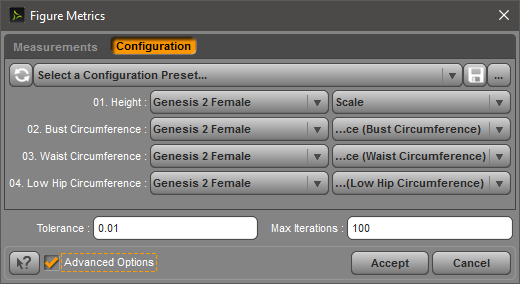

The program has been used previously to create sets of bodies for adults and children 21– 23 which were rated for characteristics such as health and body weight in the same way as digital photographs of real bodies were rated. 20 The female and male 3D models used were Victoria 5.1 (V5) and Michael 5.0 (M5), respectively. The advantages of this method are that the same identity of the body in the image for each image set is clearly maintained over a wide BMI range and the 3D rendered stimulus images are high definition and photorealistic.
#DAZ STUDIO MEASURE METRICS UNDERBUST SOFTWARE#
A more realistic representation of the bodies was therefore needed and so a 3D modelling software package (Daz Studio 4.5 from was used to create photorealistic 3D models. Following the qualitative work and team discussions it was deemed that although the 3D physical dimensions of the prototypes were anthropometrically accurate, none looked sufficiently realistic. A variety of ‘skins’ were mapped onto one of the averaged shapes to produce a range of prototype images for use in the qualitative stage of work described below (Fig. ‘very overweight’ was used instead of ‘obese’. The weight categories represented were guided by the centile cut-offs used by the NCMP 19 and their labelling terminology, i.e. The seven weight categories used were: underweight (≤second centile, clinically low weight) lower-healthy weight (2.1–49.9th centile, clinically healthy weight) mid-healthy weight (50.0–74.9th centile, clinically healthy weight) upper-healthy weight (75.0–90.9th centile, clinically healthy weight) overweight (91.0–97.9th centile, clinically overweight), lower-very overweight (98.0–99.5th centile, clinically obese) and upper-very overweight (≥99.6th centile, clinically extremely obese). To create a BIS, for each age and gender, the 3D body shapes for all children within a particular weight category were averaged and a single 3D representation of the size and shape of all the constituent bodies in that category was produced.

18 Thus the weight status of each child and their associated 3D body scan was known. 18Ĭhild height and weight measurements were used to calculate BMI (weight (kg)/height (m 2)), and child weight status using UK90 criteria. Since 4–5 and 10–11 year old children are those age groups monitored nationally, 19 the aim of this study was to create sex- and age-specific BIS of known weight status for children aged 4–5 and 10–11 years using UK90 criteria. 19 Body image scales (BIS) based on UK child populations and weight status criteria are therefore required if the utility of a visual tool in improving recognition of childhood obesity by English parents is to be examined. 10– 17 None, however, are suitable for use with parents in an English setting since they do not correspond to the British 1990 growth reference (UK90) cut points for child weight status 18 which are used nationally by the National Child Measurement Programme (NCMP) to monitor childhood overweight and obesity and inform parents of their child’s weight status. Visual representations of different child weight statuses have previously been developed and used for research purposes. 2 Research suggests that non-growth chart-based approaches should be considered 5 and, given the methods by which parents determine child weight status and their sensitivity to its more visible manifestations, 9 the use of a visual tool to improve recognition warrants further investigation. 8 Identifying methods for improving parental recognition of childhood overweight are therefore urgently needed because, without recognition, parents are unlikely to make appropriate lifestyle changes or seek support. Parental ability to correctly identify childhood overweight in the future may become even more problematic because with increasing levels of childhood overweight at a societal level comes a shift in what constitutes ‘normal’ weight toward heavier weight categories. 1– 4 This may be due to parents using visual assessments of children and comparisons with others, 5– 7 rather than using objective measures such as body mass index (BMI) or growth charts, 6, 7 when determining child weight status. Evidence indicates that parental recognition of childhood overweight is limited.


 0 kommentar(er)
0 kommentar(er)
